When ChatGPT launched in late 2022, it opened up the AI floodgates to masses of professionals. Literally thousands of new AI tools have since been released, and established brands have added AI capabilities to the platforms we already use every day.
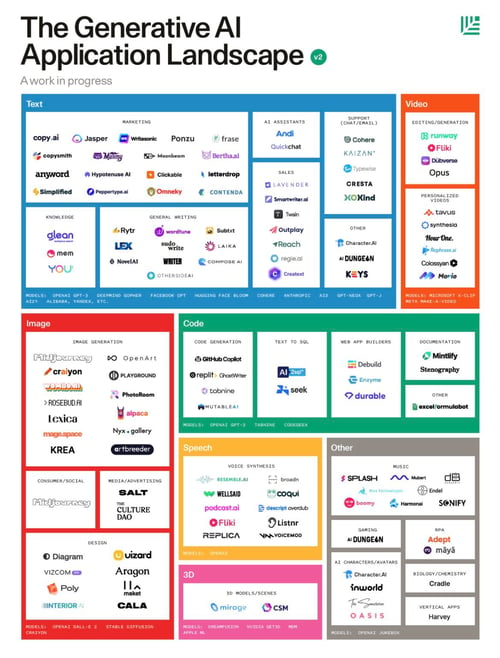 Source: @heyBarsee
Source: @heyBarsee
But the thing is, AI has been with us for years. We’re all comfortable seeing predictive text in our email, asking questions to Alexa, or using digital filters in our photos and audio files.
Still, there’s no doubt that the pace of innovation has increased from a trickle to a waterfall, and that’s led to a lot of noise and chaos in the marketplace.
People are overwhelmed — and things show no sign of slowing down.
AI tools for the modern marketer
At IMPACT, we work with businesses of all shapes and sizes — which means we see dozens of industries, team structures, and verticals. And within those organizations, we’re coaching marketing teams, training salespeople, and advising senior leadership.
In short, we see a wide swath of the professional landscape.
Below are some tools we advise clients to try out to increase their efficiency and improve their output.
For each tool, I’ll explain what it does, what it costs, the pros and cons, and my impressions — and this should give you a leg up as you’re sifting through the crowded AI landscape.
Here we go.
1. Video editing tool: Descript
Descript is an AI-powered video editor that will transcribe your footage automatically so you can edit it just like a Word document.

How you can use it
Descript uses speech detection AI to transcribe any audio or video file you feed it. The accuracy they offer is some of the highest I’ve seen. If there are errors, industry terms, or specific names you want to ensure Descript remembers moving forward, you can add them to your own glossary to be even quicker in the future, which is cool.
Another feature I found was that you can add new scenes with one click. Simply adding a slash “/” within your script will allow you to add a new scene. Descript has thousands of clips, gifs, and images to choose from to add to your video, or you can simply create your own. Little tips and tricks like this can be found in their resource center, so users can continue to learn from one another.
The user experience is very smooth and Descript allows you to apply text-based editing to save you time and ease overall. I only see Descript getting better from here and I’d expect its competitors will follow suit in terms of text-based editing for their users.
Advantages
- The dashboard operates like a drive system, allowing for collaboration with teammates
- There's voice cloning
- Magic Menu (in the Pro tier) identifies filler works and lets you decide what to remove
- Precision editing
- There are regularly held “Descript 101” webinars that get recorded and stored in a learning hub.
Disadvantages
- Transcription is about 90% accurate (This is some of the highest I’ve seen, but there is still room for improvement.)
- The voice clone can sound pixeled and robotic
- The voice clone in editing has some speech synthesis issues during long sentences
- The timeline in the video editor doesn’t let you drag/drop/slide as seamlessly as other editing tools
- You can't go into detail with keyframing and color grading, creating on-screen graphics, and/or text that you can in tools like Adobe Premier Pro
What it costs
There’s a free version, with Creator ($12/month), Pro ($24/month), and Enterprise tiers. Full details on their pricing page.
2. Long-form blog post tool: Content at Scale
Content at Scale is a top-tier AI copywriting software that uses a complex mix of three AI engines, natural language processing, and semantic analysis algorithms. It is able to crawl Google and all the top-ranking sites to put together full blog posts.
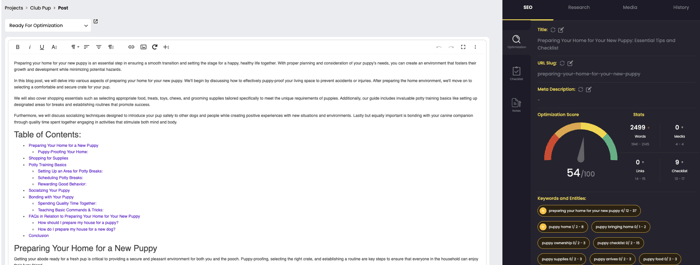
How you can use it
If I were a content writer, this would be one of the first tools I would opt to pay for. I saw the load time (explained below) as a huge disadvantage at first, but if you can plan ahead, Content at Scale will still increase your efficiency overall.
It is synced with WordPress and soon will be with HubSpot, which saves a lot of time in the publishing process.
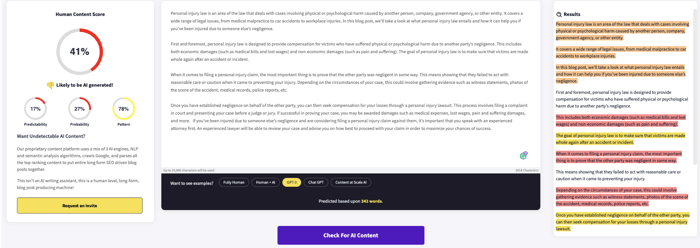
This seems to be the one tool that has the most additional features baked within it, while still having accurate output.
A human is still needed to edit the blog post before it is actually published, but this tool seems to require the least amount of editing compared to other tools.
Advantages
- Integrated with WordPress and Shopfy, with HubSpot coming soon.
- Provides an SEO optimization score and an on-page SEO checklist
- Built-in AI and plagiarism detector
- Write long-form copy from an existing blog, a YouTube Video, a podcast, or a custom audio file
- Regular how-to webinars for beginners and a quick-start tutorial page
Disadvantages
- Waitlist to have full access
- Significant load time. (They state that it takes 4-7 minutes on average for each long-form blog post to be created, but my wait time was a little over 16 minutes to create a 3600-word article.)
- The tone of voice options are limited
- SEO checker isn’t as accurate as it could be (SurferSEO or Jasper’s SEO checker are more accurate.)
- You have the option to add images, visuals, and media, but the output is sub-par
What it costs
Tiers include Solo ($250/month), Starter ($500/month), Scaling ($1,000/month), and Agency ($1,500/month)
3. Content team collaboration tool: Writer
Writer is AI content generation for your business that promises to generate on-brand writing every time. Writer claims to put your privacy first, offering the benefits of AI with no data risk.
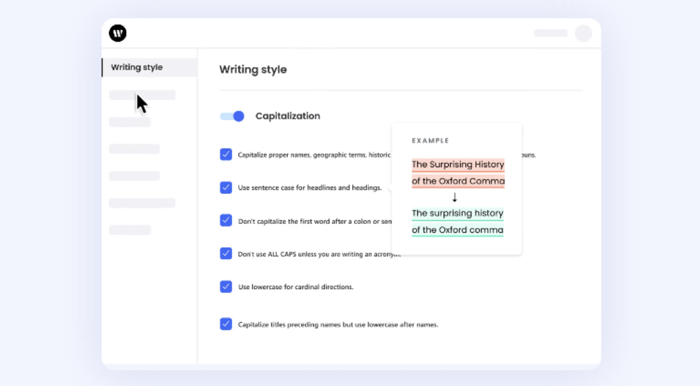
How you can use it
Initially, I didn’t see Writer as any different than Grammarly. However, the more I’ve played around with it the more I see this as a very good fit for a Senior Content Manager or somebody who leads a content team.
Having the ability to project manage all the deep details of writing within one platform for a full team is great for organizations that have strict guidelines to adhere to. For companies with specific tone and style guidelines, this would be my go-to tool.
Advantages
- The CoWrite tool acts as the writing team’s personal assistant
- A chatbot function allows you to utilize your prompt skills to train your AI (This gives you the ability to ensure your final output is relevant, updated, and accurate.)
- Writing and plagiarism checker
- You can customize your content’s tone and style to ensure your final output is on-brand
- Writer doesn’t store data its users type into the software
Disadvantages
- The user interface isn’t as easy to navigate as it could be.
- Setting up your team’s custom writing rules will take extra time at the beginning of your process.
What it costs
There’s a 14-day free trial, after which a team of 1-5 people will spend $18/month. Enterprise pricing is available if you contact the Writer team.
4. Search Engine Optimization tool: SurferSEO
Surfer SEO is a cloud-based on-page optimization tool that allows you to analyze and compare your own pages against what currently ranks in SERPs.
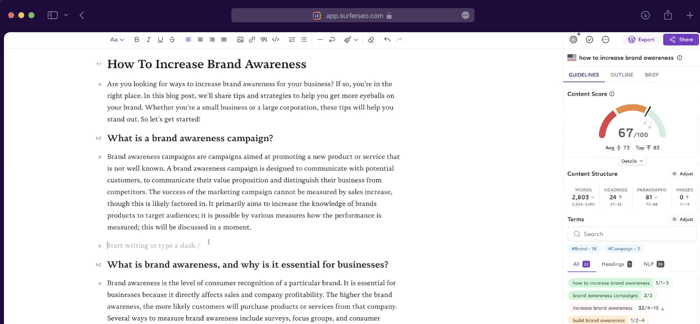
How you can use it
Through my experience with a variety of writers across a variety of industries, SEO seems to be the one thing they all overthink.
I recommend this tool quite often to my clients as they try to rank in Google. I don’t see this as a tool someone would need forever, but a great tool to utilize if you are new to SEO and don’t have the bandwidth to learn everything all at once.
I specifically love the actionable feedback it lists out for you in the SEO checker on the dashboard. This information is very direct and doesn’t leave you feeling unsure as to what you need to do to improve your content.
Advantages
- Surfer Academy offers a library learning resources
- Integrates with Google Docs and WordPress
- Edit and write right within the tool to receive your SEO score
- Analyze and compare your own pages to what ranks well already, with 500+ ranking factors
- The Content Planner tool will find related keywords and arrange them in cluster format so that you can easily create content and do internal linking
Disadvantages
- No free trial option, only a 7-day money-back guarantee
- The Domain Planner tool only supports the top 100 pages (not all pages on your site)
- The WordPress integration doesn’t work with accuracy 100% of the time
- Keyword research isn’t as intensive or descriptive as it could be
- The SERP Analyzer tool includes a lot of unnecessary data points, which can be overwhelming to make sense of
What it costs
Tiers include Basic ($49/month), Pro ($99/month), Business ($199/month), and Enterprise.
5. Time management tool: Reclaim
Reclaim is a smart scheduling app for Google Calendar that uses artificial intelligence to automatically build the perfect schedule for your priorities every week.

How you can use it
I trialed this tool for a few weeks and found it extremely helpful. With that said, I am an overly organized, color-coded planner type of individual, so I may not be the best use case for Reclaim. However, I now recommend this to my clients all the time.
It doesn’t matter what industry or what department you work in — a lot can go wrong if your calendar is chaotic. Having everything organized in one spot gives you the freedom to maximize your availability without clogging up your calendar.
The coolest part, I think, is when a meeting is canceled or something shifts in your calendar, Reclaim will auto-reschedule it for you at an opportune time.
And lastly, Reclaim will adjust your events from “Free” to “Busy” as you get busier — so you stay flexible, but not overly available.
Advantages
- Reclaim 101 offers live educational webinars
- Integrates with Google Calendar, Slack, Click Up, and more
- Sync unlimited calendars (and availability) to prevent conflicts
- Auto-block time for tasks and routines and find the best time for 1:1 meetings
- Add breaks and travel time around meetings
- Reprioritize your entire calendar easily when things change
Disadvantages
- Does not integrate with Outlook
- There is a learning curve when you first start using the tool
- You cannot access all of the functions from your own calendar — you will have to have the app open in another tab to have full access
- Notifications can become overwhelming quickly, though they can be adjusted
My thoughts
I trialed this tool for a few weeks and found it extremely helpful. With that said, I am an overly organized, color-coded planner type of individual, so I may not be the best use case for Reclaim. However, I now recommend this to my clients all the time.
It doesn’t matter what industry or what department you work in — a lot can go wrong if your calendar is chaotic. Having everything organized in one spot gives you the freedom to maximize your availability without clogging up your calendar.
The coolest part, I think, is when a meeting is canceled or something shifts in your calendar, Reclaim will auto-reschedule it for you at an opportune time. And lastly, Reclaim will adjust your events from “Free” to “Busy” as you get busier — so you stay flexible, but not overly available.
What it costs
Lite (free for life), Starter ($8/month per user), Business ($12/month per user), Enterprise ($18/month per user).
The tool is only as good as the person who uses it
While these tools open up amazing possibilities, remember that they, themselves, are not a strategy. They are not insight or creativity, either.
Let these tools enhance and speed up the work you do, but don’t expect them to do the job for you.

And remember, the AI landscape is shifting by the day. These tools will improve, others will emerge, and category kings will eventually come to dominate.
Keep experimenting and learning.
* This article was originally published here
No comments:
Post a Comment